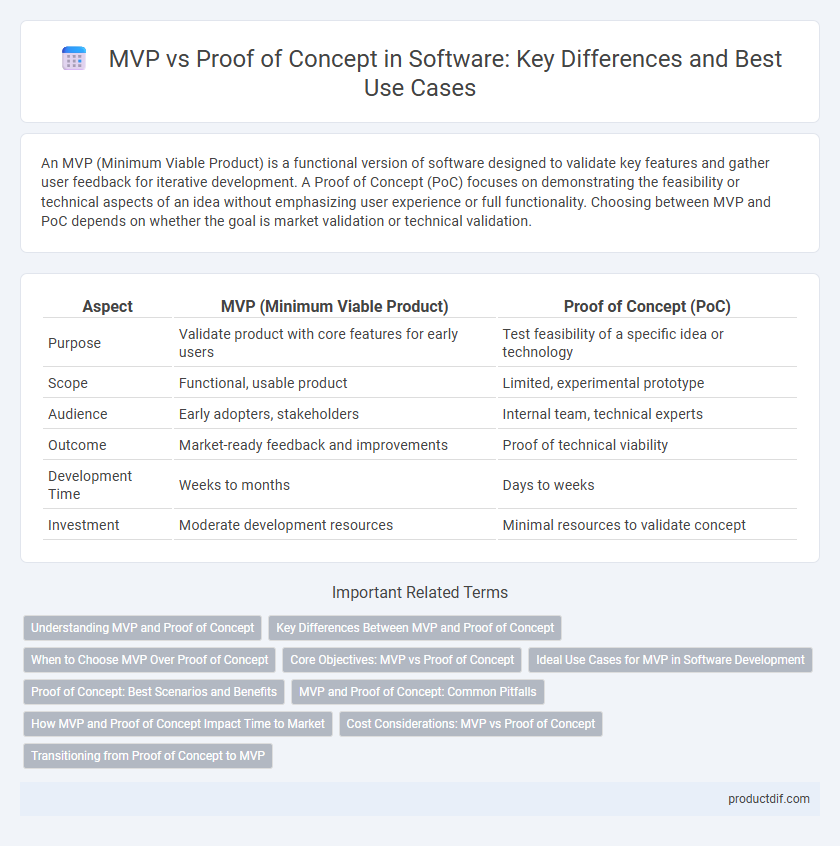An MVP (Minimum Viable Product) is a functional version of software designed to validate key features and gather user feedback for iterative development. A Proof of Concept (PoC) focuses on demonstrating the feasibility or technical aspects of an idea without emphasizing user experience or full functionality. Choosing between MVP and PoC depends on whether the goal is market validation or technical validation.
Table of Comparison
| Aspect | MVP (Minimum Viable Product) | Proof of Concept (PoC) |
|---|---|---|
| Purpose | Validate product with core features for early users | Test feasibility of a specific idea or technology |
| Scope | Functional, usable product | Limited, experimental prototype |
| Audience | Early adopters, stakeholders | Internal team, technical experts |
| Outcome | Market-ready feedback and improvements | Proof of technical viability |
| Development Time | Weeks to months | Days to weeks |
| Investment | Moderate development resources | Minimal resources to validate concept |
Understanding MVP and Proof of Concept
A Minimum Viable Product (MVP) is a functional software version with core features designed to validate market demand and gather user feedback for iterative development. A Proof of Concept (PoC) focuses on testing feasibility and technical viability of a specific idea or technology without addressing full product functionality. Both serve distinct purposes in software development: PoC reduces technical risk early, while MVP validates market acceptance.
Key Differences Between MVP and Proof of Concept
A Minimum Viable Product (MVP) focuses on delivering core functionalities to validate market demand and gather user feedback, whereas a Proof of Concept (PoC) aims to test the feasibility of a specific technology or idea before full-scale development. MVP involves developing a usable product with essential features for early adopters, while PoC is typically a small-scale, experimental prototype to demonstrate technical viability. Key differences include MVP's market validation purpose versus PoC's technical assessment focus, development scope, and target audience.
When to Choose MVP Over Proof of Concept
Choosing an MVP over a Proof of Concept is ideal when there is a need to validate market demand through real user interactions, enabling iterative development based on feedback. MVPs deliver functional products with core features, facilitating early revenue generation and investor confidence. This approach is preferred when the goal includes testing usability, scalability, and business model viability beyond just technical feasibility.
Core Objectives: MVP vs Proof of Concept
A Minimum Viable Product (MVP) aims to deliver a functional version of a software product with just enough features to satisfy early users and gather feedback for iteration. In contrast, a Proof of Concept (PoC) validates the technical feasibility and potential of an idea or technology without full user functionality. While MVP focuses on user engagement and market fit, PoC is primarily concerned with demonstrating that a proposed solution can be practically implemented.
Ideal Use Cases for MVP in Software Development
MVP (Minimum Viable Product) is ideal in software development when testing product-market fit by releasing a functional version to gather real user feedback and validate core features quickly. It suits startups aiming to enter the market fast with essential functionalities, reducing development costs and risks. MVP helps prioritize features based on user interaction, enabling iterative improvements that align closely with user needs and business goals.
Proof of Concept: Best Scenarios and Benefits
Proof of Concept (PoC) is ideal for validating the feasibility of innovative software ideas before extensive development, reducing risks associated with unproven technologies. It enables stakeholders to assess technical challenges early, ensuring alignment with business objectives and resource allocation. Implementing a PoC accelerates decision-making by demonstrating potential solutions' viability, saving time and development costs in the product lifecycle.
MVP and Proof of Concept: Common Pitfalls
MVP and Proof of Concept (PoC) often face pitfalls such as unclear objectives, leading to wasted resources and misaligned development priorities. Teams frequently underestimate the importance of validating market demand during an MVP, resulting in products that fail to meet customer needs. Overemphasis on technical feasibility in PoC without considering user feedback can cause projects to stall before reaching viable stages.
How MVP and Proof of Concept Impact Time to Market
MVP (Minimum Viable Product) accelerates time to market by delivering a functional product with essential features that enables early user feedback and iterative improvements. Proof of Concept (PoC) reduces risk by validating technical feasibility before full development but typically extends initial timelines since it doesn't produce a market-ready product. Choosing between MVP and PoC depends on whether the priority is quick market entry or early technical validation.
Cost Considerations: MVP vs Proof of Concept
Proof of Concept (PoC) typically incurs lower initial costs aimed at validating core feasibility without full development. In contrast, a Minimum Viable Product (MVP) demands higher investment by creating a functional product with essential features to attract early users and gather feedback. Budget allocation for PoC centers on experimentation, while MVP expenses emphasize design, development, and user experience to ensure market viability.
Transitioning from Proof of Concept to MVP
Transitioning from Proof of Concept (PoC) to Minimum Viable Product (MVP) involves evolving a basic demonstration of feasibility into a functional product designed for initial user feedback and market validation. Key steps include refining core features, enhancing user experience, integrating scalable architecture, and addressing technical debt identified during the PoC phase. This progression requires aligning development efforts with business objectives to ensure the MVP effectively validates product-market fit and supports iterative improvement.
MVP vs Proof of Concept Infographic

 productdif.com
productdif.com